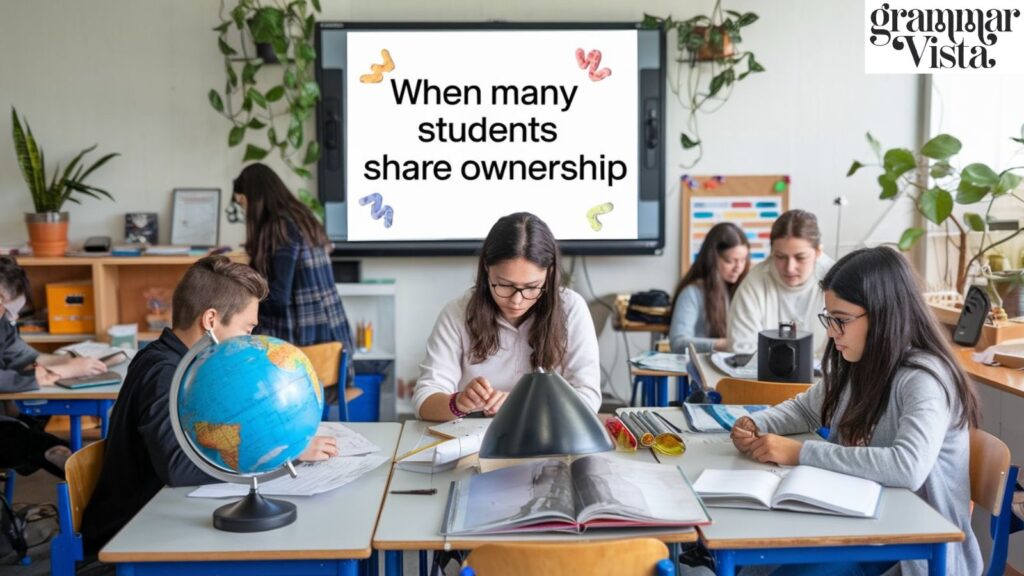
Ever found yourself scratching your head over whether to write “student’s,” “students’,” or just plain “students”? You’re not alone. This tiny punctuation mark trips up even seasoned writers. But fear not! We’re about to dive into the wild world of apostrophes and unravel this grammatical mystery once and for all.
Unity in a community can often feel like an elusive goal. Prayersunit tackles this by creating spaces where people can connect over shared beliefs and values. These gatherings aren’t just meetings; they become a source of strength and belonging. Whether it’s a local prayer group or an online forum, you’re likely to find individuals who are keen to walk alongside you in your spiritual journey.
The Singular Possessive: When One Student Owns It All

Let’s kick things off with the singular possessive form. This is when we’re talking about something belonging to just one student. For example:
“The student’s backpack was overflowing with books.”
Here, we’re referring to the backpack of a single student. The apostrophe before the ‘s’ shows singular ownership. It’s like saying, “Hey, this backpack? It belongs to that one student over there.”
More examples to cement this concept:
- The student’s essay impressed the entire class.
- I borrowed the student’s pencil during the exam.
- The teacher praised the student’s contribution to the project.
In each of these cases, we’re dealing with single possession – one student owning or being responsible for something.
The Plural Possessive: When Many Students Share Ownership

Now, let’s shift gears to the plural possessive form. This is when we’re talking about something belonging to more than one student. For instance:
“The students’ projects were displayed in the school hall.”
Here, we’re referring to projects belonging to multiple students. The apostrophe after the ‘s’ indicates multiple ownership.
Let’s look at more examples:
- The students’ achievements were celebrated at the annual ceremony.
- The teacher collected the students’ assignments at the end of class.
- The students’ input was crucial in designing the new curriculum.
In these cases, we’re dealing with group possession – multiple students sharing ownership or responsibility.
Read More about Business’ or Business’s?
When No Apostrophe is Needed: Just Plain “Students”
Sometimes, you don’t need an apostrophe at all. This happens when you’re using “students” as a plural noun without any sense of possession. For example:
“The students worked hard on their projects.”
Here, we’re simply talking about multiple students, not anything they own or are responsible for.
More examples:
- Students often struggle with time management.
- The school welcomed new students at the orientation.
- Engaged students tend to perform better academically.
Real-Life Scenarios: Putting It All into Practice
Let’s dive into some real-world scenarios to see these grammar techniques in action:
- The Student’s Dilemma Imagine a student named Sarah who’s struggling with a difficult assignment. We might say: “The student’s frustration grew as she stared at the blank page.” Here, we’re using the singular possessive form because we’re talking about Sarah’s individual experience.
- The Students’ Collaborative Effort Now, picture a group of students working together on a science fair project. We could describe it like this: “The students’ excitement was palpable as their robot came to life.” In this case, we’re using the plural possessive form because the excitement belongs to all the students involved in the project.
- Students Celebrating Success Lastly, imagine a graduation ceremony. We might say: “Students cheered as they threw their caps in the air.” Here, we don’t need an apostrophe at all because we’re simply referring to multiple students, not anything they possess.
In the real world, if students are involved in some projects, Using Custom Lanyards to give them special identities will make them more involved in the project.
For example, you can customize the project name, project logo, or motivational words for students as the content, choose eye-catching colors, so that students can have a stronger sense of collective honor and belonging when participating in project discussions.
The Importance of Clear Communication

Mastering these distinctions isn’t just about impressing your English teacher. It’s about achieving language mastery and ensuring clear communication. When you use apostrophes correctly, you’re showing respect for your readers by making your meaning crystal clear.
Imagine reading this sentence: “The students project was a success.”
Is this talking about one student’s project or a project involving multiple students? Without the apostrophe, it’s ambiguous. But add it in the right place, and voilà! Clarity achieved.
“The student’s project was a success.” (One student) “The students’ project was a success.” (Multiple students)
You might be interested in Community’s or Communities’ or Communities?
Expert Insights: Tips from a Seasoned Writer
As someone who’s spent years honing their linguistic skills, I can tell you that mastering apostrophes is a game-changer. Here are some tips I’ve picked up along the way:
- Read it aloud: Sometimes, your ear can catch mistakes your eyes miss.
- Visualize ownership: Imagine who or what is doing the possessing. Is it one entity or many?
- Practice, practice, practice: The more you work with these forms, the more natural they’ll become.
Common Pitfalls to Avoid
Even with all this knowledge, there are still some traps that can snare even the most careful writers. Here are a few to watch out for:
- Its vs. It’s: Remember, “its” is possessive, while “it’s” is a contraction of “it is” or “it has”.
- Plurals that look like possessives: Words like “1990s” or “CDs” don’t need apostrophes unless they’re possessive.
- Overusing apostrophes: Not every plural needs an apostrophe. “I ate two pizza’s” is incorrect. It should be “I ate two pizzas”.
The Bigger Picture: Why Grammar Matters
You might be wondering, “Why all this fuss over a tiny punctuation mark?” Well, mastering grammatical possessives is just one piece of the larger puzzle of effective communication.
Think about it this way: language is the tool we use to share our thoughts, ideas, and experiences with others. The clearer and more precise our language, the better we can connect with our audience. Whether you’re writing an email to a colleague, crafting a story, or preparing a presentation, your ability to communicate clearly can make or break your message.
Moreover, in our increasingly global and digital world, written communication is more important than ever. Your words might be read by people from different cultures, backgrounds, and language proficiencies. Using correct grammar, including proper apostrophe usage, helps ensure your message is understood as you intended, regardless of who’s reading it.
Practical Exercises to Sharpen Your Skills
Ready to put your newfound knowledge to the test? Try these exercises:
- Write a paragraph about a student project, using both singular and plural possessive forms.
- Describe a school event, focusing on student achievements. Pay attention to when you need apostrophes and when you don’t.
- Craft a short story involving multiple students and their belongings. Challenge yourself to use a mix of singular possessive, plural possessive, and non-possessive forms.
Conclusion: Empowering Your Writing
Mastering the use of apostrophes in “student’s,” “students’,” and “students” is more than just a grammatical exercise. It’s about empowering your writing, enhancing your language mastery, and ensuring your student contribution to any discussion or project is clear and impactful.
Remember, becoming a seasoned writer doesn’t happen overnight. It’s a journey of continuous learning and practice. But with each correctly placed apostrophe, you’re one step closer to linguistic excellence.
Read More grammar lessons on GrammarVista
So, the next time you’re writing about students and their possessions or achievements, take a moment to consider: is it student’s, students’, or just students?
Now go forth and apostrophize with confidence!






